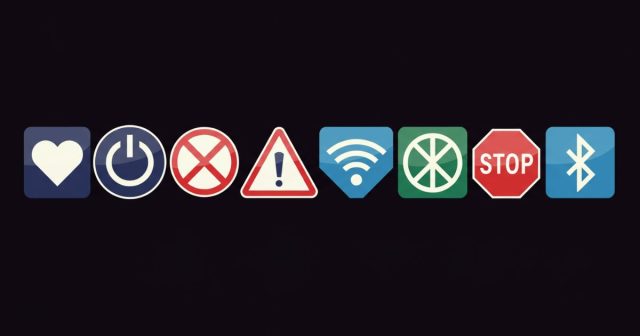From the simple heart icon on your phone to the ubiquitous recycling symbol stamped on plastic bottles, symbols surround us. We see them on road signs, product packaging, and digital screens, often without a second thought. Yet behind each of these commonly used icons lies a rich history, a designer’s intention, or a cultural quirk that reveals more about human communication and collective psychology than you might imagine. In this post, we’ll journey through the hidden origins and surprising meanings of some of the most familiar symbols in our lives. By the end, you’ll never look at these little images the same way again.
1. The Heart Icon: From Valentine’s Verse to Screen Tap
The simple heart shape is arguably the most recognized symbol of love and affection. Yet if you compare it to an anatomical heart, the resemblance is almost nonexistent. So where did it come from? One theory traces it back to the 14th century, when medieval manuscripts depicted the seedpod of the silphium plant—used as a seasoning and contraceptive—which had a distinctive heartlike silhouette. Others point to early representations of ivy and fig leaves, both associated with fidelity in Greek and Roman cultures. By the time the symbol appeared on playing cards in the 15th century, it had already acquired romantic connotations. Fast-forward to the digital age, and the heart icon now transcends romance entirely, becoming a versatile “like” button that conveys appreciation, support, or even simple acknowledgment on social media and messaging apps.
![]()
2. The Recycling Symbol: A Mobius Twist of Ecology
Look closely at that triangular loop chasing its own tail—you’re looking at a simplified Möbius strip. Designed in 1970 by a college student for a contest held by the Container Corporation of America, the three chasing arrows stand for “reduce, reuse, recycle.” What elevates this design is its mathematical nod to infinity: the Mobius strip has just one side and one boundary, symbolizing an endless cycle. Today, that clever geometric shape has become an international mark of sustainability and environmental awareness. Major brands, governments, and nonprofits license or adapt the logo, ensuring that recycled materials remain within a closed loop instead of ending up in landfills.

3. The Power Button: Binary Roots and Global Recognition
Next time you press the power button on your laptop or TV, take a moment to appreciate the binary magic behind it. The universal power symbol—a circle bisected by a vertical line—originates from the IEC (International Electrotechnical Commission) standard. It merges the binary digits 1 (on) and 0 (off) into one icon, signifying toggling between states. Invented in the 1940s, it became standardized in the 1970s to simplify user interfaces across languages and cultures. Today, it offers an elegant answer to “turn it on” or “turn it off” without relying on words, ensuring a seamless user experience worldwide.
4. The Wi-Fi Signal: Invisible Waves Made Visible
The familiar arc-shaped bars on your phone screen represent radio waves radiating outward. When the Wi-Fi Alliance introduced the term “Wi-Fi” and its corresponding logo in 1999, there was a challenge: how to graphically depict an invisible phenomenon. The solution was deceptively simple—concentric quarter-circles suggesting waves, over a dot representing the transmitter. Over two decades later, this icon is synonymous with wireless connectivity, internet access, and the freedom to work or stream almost anywhere. It’s a striking example of turning an abstract scientific concept into an intuitively understood everyday graphic.
5. Road Signs: From Ancient Symbols to Modern Safety
Road signs combine utility and semiotics—short, impactful symbols that convey essential information at high speeds. Some date back to the Roman Empire, where milestones and milestonesets guided travelers. In the 20th century, with the rise of automobiles, the need for standardized signs became urgent. The Vienna Convention on Road Signs and Signals (1968) harmonized designs worldwide: a red circle means prohibition, a triangle warns, and a blue circle mandates action. Whether you’re in Paris, Perth, or Pittsburgh, these shapes and colors communicate universally—an impressive feat of global consensus and human-centered design.
6. The Peace Symbol: A Misguided Nuclear Message
Often called the “peace sign,” this circle with three lines is actually a nuclear disarmament emblem. Created in 1958 by Gerald Holtom for the British Campaign for Nuclear Disarmament, it combines the semaphore signals for the letters N and D, standing for “nuclear” and “disarmament.” Ironically, it was meant as a protest against nuclear weapons, not a general peace emblem. Yet over the 1960s, anti-war activists adopted it, and it morphed into a universal peace icon. Its adaptability across movements underscores how symbols can escape their original context to gain broader cultural significance.
7. The Bluetooth Logo: A Viking’s Secret Code
Bluetooth wireless technology gets its name from a 10th-century Scandinavian king, Harald “Bluetooth” Gormsson, who united warring Danish tribes. The Bluetooth logo cleverly merges two runes: Hagall (ᚼ) and Bjarkan (ᛒ), representing the letters H and B. This “bind rune” represents unifying communication protocols, just as King Harald unified territories. Today, the Bluetooth mark appears on billions of devices, encapsulating a playful nod to history alongside cutting-edge connectivity technology.
8. The Stop Sign: A Study in Visibility
It’s hard to imagine a red octagon with the word STOP in white looking any different—but it wasn’t always so. Early stop signs were yellow, because yellow was considered the most visible at dawn and dusk. In 1954, U.S. transportation authorities standardized the current red-and-white design, leveraging red’s universal association with danger and urgency. The octagon shape was also standardized so that even a rotated sign (for example, partially obscured by foliage) would be recognizable by shape alone. Today, it’s a prime example of form following function in public safety design.
9. Currency Symbols: Economy in a Single Glyph
Ever wondered why the dollar sign looks like an S with one or two vertical lines? One theory suggests it originated from the Spanish peso, abbreviated ‘P S,’ which over time merged into a single symbol. The euro symbol (€), on the other hand, was designed in 1996 to reflect the Greek epsilon (ϵ) and the “E” for Europe, with two parallel lines indicating stability. Currency symbols distil complex economic systems into a single character, reinforcing national identity and global commerce at a glance.
10. Food Labels: Nutrition Facts in Icon Form
In an age of information overload, food icons—like the gluten-free ear of wheat crossed out, the kosher star, or the vegan V enclosed in a circle—offer instant clarity. These certifications began as government regulations or third-party endorsements but have evolved into powerful marketing tools. They serve both consumer protection and brand positioning, giving shoppers the confidence to make choices aligned with dietary needs, religious practices, or ethical beliefs. The next time you reach for a snack, notice how these small icons carry big trust.
Conclusion: The Power of Simple Images
Symbols are the silent ambassadors of human thought. They distill complex ideas—love, danger, unity, permission—into bite-sized visual cues that cross languages and cultures. By examining their origins and evolutions, we not only appreciate clever design, but also glimpse the collective values, fears, and aspirations of societies through time. This is one of the many everyday wonders that show how ordinary icons can carry extraordinary meaning. So next time you tap that heart icon, navigate city streets, or unplug your device with the power button, remember: there’s a rich backstory behind these symbols, waiting to be discovered.









